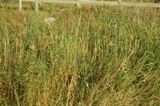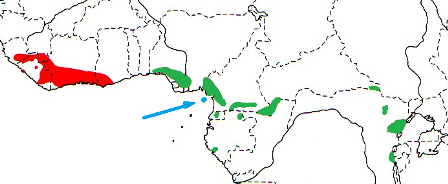Weaver species
Choose different species from drop-down list and press 'Go' button. See Full species list.Maxwell's Black Weaver Ploceus albinucha
IUCN: Least concern Discovery: 072Categories: black, fruit, nectar, palm,
News items about species
Discovery
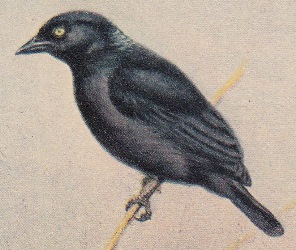
figure from Bannerman (1949) 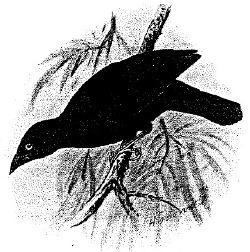
figure from Bannerman (1949) 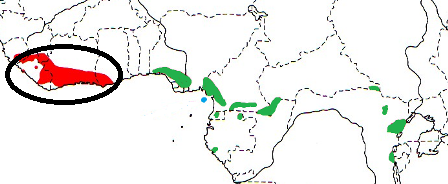
distribution, type locality circled 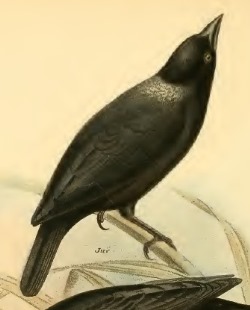
prob is Maxwell's Black Weaver figure from Bartlett (1888) IntroductionThe Maxwell's Black Weaver was formally described by Jose Vicente Barbosa du Bocage, a Portuguese zoologist and politician. He was curator of the Lisbon Museum.Richard Bowdler Sharpe, an English zoologist, obtained the Maxwell's Black Weaver specimen from Henry Whitely, a British dealer in bird skins living at 28 Wellington Street, Woolwich. His son, also Henry Whitely, travelled in Japan and South America to collect bird specimens. It is not known from whom Whitely (senior) obtained the Maxwell's Black Weaver specimen. Dowsett-Lemaire & Dowsett (2014) suggested that the specimen was from Ghana. Sharpe sent a collection of birds (mostly from Quanza, Angola) to Bocage who was interested in Angolan specimens. The Maxwell's Black Weaver type was included in the collection (perhaps accidentally), but its label clearly stated "West Africa". Because of it being with the Angolan birds, many authors incorrectly gave the type locality for Maxwell's Black Weaver as Quanza in Angola but it should always have been listed as West Africa. Unfortunately the type no longer exists, due to a fire in the Lisbon Museum in 1978. The first illustrations of the Maxwell's Black Weaver were published in Bannerman (1949), the first in colour and of the nominate subspecies, and the second in black and white of another subspecies. Bartlett (1888) wrote a text on Maxwell's Black Weaver and referred to a plate for this species, but the plate seems to be missing from the book. Scientific citationSycobius albinucha Bocage 1876 Jorn. Sci. Math. Phys. Nat. Lisboa, 5, p.247 West Africa.Meaning of namesalbinucha, Latin: albus, white; Med. Latin nucha, the nape (Arabic nukha, spinal marrow).First English nameThe White-naped Weaver (Bartlett 1888).Alternate namesBlack Weaver, Fernando Po Black Weaver, Maxwell's Weaver, White-naped Black Weaver, White-naped Weaver.Collectorvia Henry Whitely.Date collectedBefore 1876.Locality collectedWest Africa, possibly Ghana.Type specimensThe type specimen was in the Museum of Lisbon, before a fire destroyed the museum. |
The above is based on Weaver Wednesday 2, a weekly series about the discovery of each weaver species.
This species text first appeared as
Weaver Wednesday [189] - Discovery [72]: Maxwell's Black Weaver on 2016-01-27
1. Basic biology
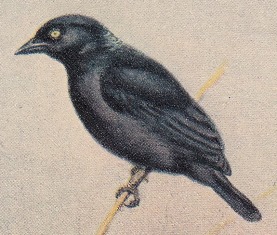
nominate race with white nape feathers figure from Bannerman 1949 Distribution.
Maxwell's Black Weaver occurs from West Africa to central Africa (see map below, based on Birds of Africa). There are three subspecies:
Habitat. Maxwell's Black Weaver inhabits high forest in Cameroon; elsewhere it is found in the vicinity of villages surrounded by secondary forest, often near rivers and creeks. Maxwell's Black Weaver formst large, noisy roosts in the evening. Food. Maxwell's Black Weaver feeds on insects including grasshoppers, small caterpillars, and chrysalises. It also feeds on fruit, berries, and nectar. It hawks insects in the canopy. Maxwell's Black Weaver forages in mixed-species flocks but single birds may be found high in the canopy. Breeding. Maxwell's Black Weaver is probably polygynous. It is colonial, with 20-500 nests in a colony. It may form mixed colonies with other weaver species. The nest of Maxwell's Black Weaver is a rough hemisphere with the entrance below and almost no tunnel. The nest is constructed of thin, rough creepers, or is woven from strips of banana leaf. The nest is placed at the tip of a branch or palm frond. The nests are usually high up, in the crown of trees. A colony of 20 nests in Sierra Leone was directly below the nest of a Crowned Hawk-eagle Stephanoetus coronatus. The eggs are undescribed and nothing else is known about breeding. Young birds are sometimes harvested by villagers. |
The above is based on Weaver Wednesday, a weekly series about weaver species.
This species text first appeared as
Weaver Wednesday [109]: Maxwell's Black Weaver on 2014-07-16
2. Breeding facts
| Pair bond probably polygynous Breeding season In W Africa, active nests in Feb in Siena Leone, fledglings seen Nov-Dec in Liberia and Ghana, and birds with enlarged gonads in Mar in Cameroon; breeds Feb and Jun-Aug in DRCongo Nest site placed at tip of pendulous branch generally high in crown of tree, more than 10 m above ground Nest building no information Colony size Colonial, with 20-500 nests in colony Clutch size no information Egg colour no information Egg size no information Incubation no information Chicks and nestling period no information |
Breeding information based on Handbook of the Birds of the World, Vol. 15.
3. Photos of Weaver Nests
No records yet - be the first to submit a PHOWN record!See PHOWN summary page for this species here.
PHOWN (Photos of Weaver Nests) provides valuable info on breeding distribution and colony sizes of weavers.
You can contribute by registering and submitting photos at Virtual Museum webpage.
4. Breeding distribution
Google map showing distribution (For species with small ranges you need to zoom in at the correct area to see the range):
yellow blob - range of weaver species; read more about this here.
![]() - PHOWN records with photos
- PHOWN records with photos
![]() - PHOWN records with no photos (Nest Record Cards, other records)
- PHOWN records with no photos (Nest Record Cards, other records)
![]() - Birdpix records
- Birdpix records
![]() - comments on out of range records, or interesting records
- comments on out of range records, or interesting records
![]() - type locality
- type locality
CLICK on the marker on the map to see individual record details.
5. Range changes
Not South African speciesThe above is based on Weaver Wednesday 3, a weekly series about range changes in South African weaver species.
This species text first appeared as
n/a








